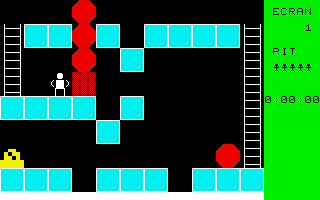I think I had actually searched on "great basic games", which is probably why I found it. One of the "goals" of my hobby is to try to bring to the MC-10 as many of the great/most classic basic games of the 8-bit era as I can. So I was interested to see that the game didn't look overly complex in its screen graphics:
 |
| Original Version |
 |
| MC-10 Version |
The original game was called "Pitman" and it is essentially a puzzle solving adventure game similar in style to Sokoban (which I have created a version for the MC-10 using the screens transferred from an OS9 text version made for the Coco that I got from the old RTSI OS9 software archive):
Pitman was very nicely programmed by Isokawa and only used the 40*24 text graphic characters of the MZ700. The original graphics were based on the use of 3X3 characters. By reducing these to 2X2 character VDG graphic equivalents, I was able to adjust the game to the much smaller MC-10 32*16 screen. Then it was just a matter of making sure all "scaling" factors used in the program were adjusted to the new regime. The game also included level editor and save/load functions, which I have now fully implemented for use on both an MC-10 cassette system and Coco disk system.
Obviously the MC-10 graphics are a little more chunky than the original, but as a dedicated MC-10er, I have come to revel in the glorious chunky graphics of my favourite 8-bit machine. After all, the visible squarish pixel is the very symbol and essence of "8-bit." And in that regard, the MC-10 is king!
I have added the latest version of Coco Pitman to my JGGAMES5.DSK, which is available from my GitHub site: https://github.com/jggames
I've updated the title page to look more like the original and added disk directory and save features to the screen editing section of program.

No comments:
Post a Comment